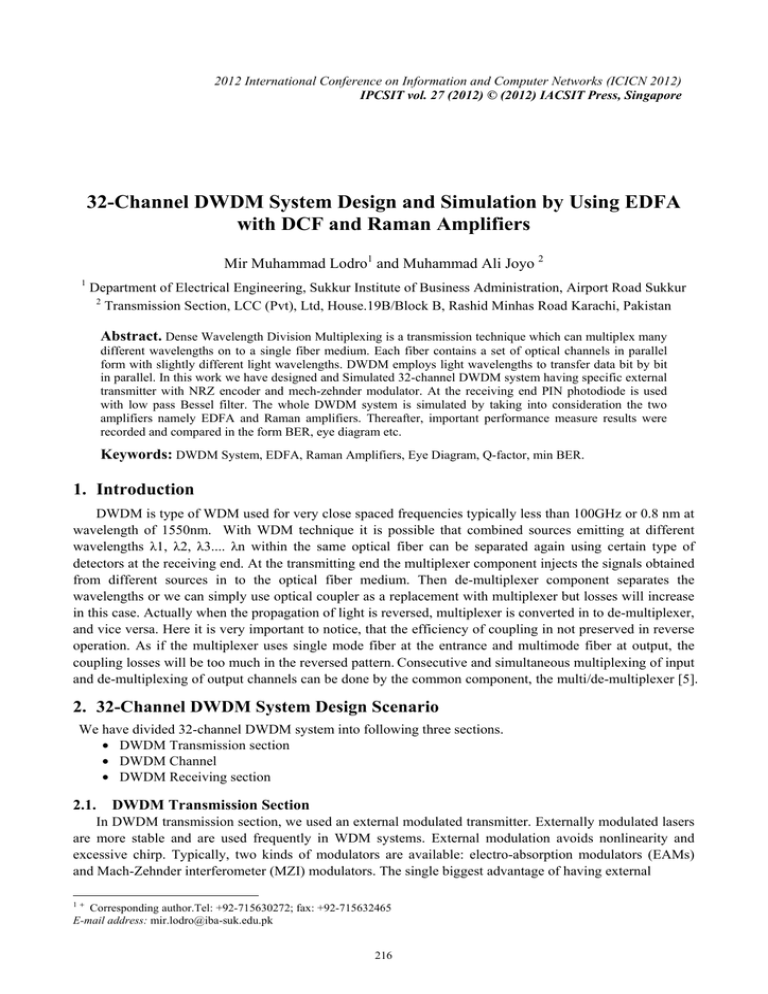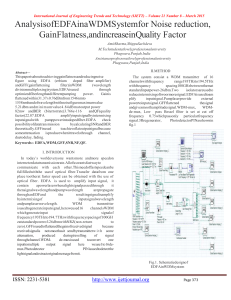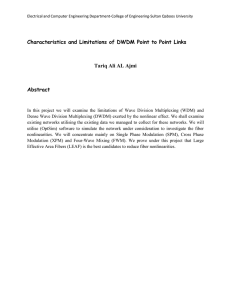32-Channel DWDM System Design and Simulation by Using EDFA
advertisement

2012 International Conference on Information and Computer Networks (ICICN 2012) IPCSIT vol. 27 (2012) © (2012) IACSIT Press, Singapore 32-Channel DWDM System Design and Simulation by Using EDFA with DCF and Raman Amplifiers Mir Muhammad Lodro1 and Muhammad Ali Joyo 2 1 Department of Electrical Engineering, Sukkur Institute of Business Administration, Airport Road Sukkur 2 Transmission Section, LCC (Pvt), Ltd, House.19B/Block B, Rashid Minhas Road Karachi, Pakistan Abstract. Dense Wavelength Division Multiplexing is a transmission technique which can multiplex many different wavelengths on to a single fiber medium. Each fiber contains a set of optical channels in parallel form with slightly different light wavelengths. DWDM employs light wavelengths to transfer data bit by bit in parallel. In this work we have designed and Simulated 32-channel DWDM system having specific external transmitter with NRZ encoder and mech-zehnder modulator. At the receiving end PIN photodiode is used with low pass Bessel filter. The whole DWDM system is simulated by taking into consideration the two amplifiers namely EDFA and Raman amplifiers. Thereafter, important performance measure results were recorded and compared in the form BER, eye diagram etc. Keywords: DWDM System, EDFA, Raman Amplifiers, Eye Diagram, Q-factor, min BER. 1. Introduction DWDM is type of WDM used for very close spaced frequencies typically less than 100GHz or 0.8 nm at wavelength of 1550nm. With WDM technique it is possible that combined sources emitting at different wavelengths λ1, λ2, λ3.... λn within the same optical fiber can be separated again using certain type of detectors at the receiving end. At the transmitting end the multiplexer component injects the signals obtained from different sources in to the optical fiber medium. Then de-multiplexer component separates the wavelengths or we can simply use optical coupler as a replacement with multiplexer but losses will increase in this case. Actually when the propagation of light is reversed, multiplexer is converted in to de-multiplexer, and vice versa. Here it is very important to notice, that the efficiency of coupling in not preserved in reverse operation. As if the multiplexer uses single mode fiber at the entrance and multimode fiber at output, the coupling losses will be too much in the reversed pattern. Consecutive and simultaneous multiplexing of input and de-multiplexing of output channels can be done by the common component, the multi/de-multiplexer [5]. 2. 32-Channel DWDM System Design Scenario We have divided 32-channel DWDM system into following three sections. • DWDM Transmission section • DWDM Channel • DWDM Receiving section 2.1. DWDM Transmission Section In DWDM transmission section, we used an external modulated transmitter. Externally modulated lasers are more stable and are used frequently in WDM systems. External modulation avoids nonlinearity and excessive chirp. Typically, two kinds of modulators are available: electro-absorption modulators (EAMs) and Mach-Zehnder interferometer (MZI) modulators. The single biggest advantage of having external 1+ Corresponding author.Tel: +92-715630272; fax: +92-715632465 E-mail address: mir.lodro@iba-suk.edu.pk 216 modulators is the reduced chirp, which means that the signal occupies less bandwidth. Typically, MZI modulators are known to have twice the bit rate as their bandwidth. This also means that the spacing between adjacent channels in a WDM system can be greatly reduced. Most external modulators use the NRZ modulation format. RZ and CS-RZ modulation formats are also used in WDM systems [4].Here we used NRZ modulation along with MZI modulator getting laser input from the CW laser. In our model WDM Ideal MUX with simple parameters having 32 input ports and 1 output port is used. 2.2. DWDM channel In practical DWDM system channel can be varying types, here we have examined two channels using following two different types of amplifiers. • EDFA pumped fiber channel • Raman pumped fiber channel 2.2.1 EDFA pumped fiber channel . In these devices, the signal to be amplified and an optical pump are superposed. The pump excites the doping ions: rare earth such as erbium, praseodymium, and neodymium, to a higher energy level from which amplification takes place by stimulated emission. Among these potential amplifiers the erbium fiber amplifiers is suitable for the 1550nm transmission window [5]. Fig.1 : External Modulated Transmitter Fig.2 : DWDM Transmission Section In our 32-channel DWDM system we used the medium having EDFA as amplifier combined with SMF and DCF. When designed a channel, an EDFA is added after the length of 50km to compensate the linear loss. In 1550nm supported optical fiber the basic reason which restricts the high speed signal is linear dispersion [7]. The dispersion of SMF in 1550 nm window is 16.75ps/nm/km, therefore DCF should be used to compensate with the dispersion. DCF has chromatic dispersion in negative (-90ps/nm/km), So if the length of DCF is 1/5th of the SMF, then the total transmission line dispersion value is close to zero [3]. But as DCF have larger attenuation, to cope with this issue EDFA is added again to compensate the linear loss in the end of channel after DCF. 2.2.2 Raman pumped fiber channel Raman scattering converts a small portion of an incident frequency in to other frequencies. The effect can be stimulated and used in order to transfer energy from pump laser to a weak signal. Thus the simultaneous amplification of several multiplexed wavelengths is possible and was proposed in 1987[8]. However, the problem of crosstalk between channels is particularly difficult to solve [9].Raman amplifier works around 1330nm and 1550nm with pumps at 1240nm and 1420nm respectively, as a counter-propagating scheme showed bandwidth of 65 and 100nm respectively [10].Raman amplifiers require more pump power than EDFAs but provide lower nonlinear crosstalk than EDFAs when used as distributed amplifiers [11] Here when designing channel using Raman pumped amplifier, we selected the Raman amplifier average power model provided in Optisystem8.0, as shown below in fig.4 217 Fig.3: EDFA along with SMF and DCF 2.3. Fig.4: Raman Amplifier model used in 32-channel DWDM system. DWDM Receiving Section. At the receiving section we have used ideal de-multiplexer having simple parameters with 1 input and 32 outputs where receivers detect optical pulses and convert them back into electrical bits. The two widely used photodiode as receiver are as follows • • PIN photodiode Avalanche photodiodes (APDs) PIN photodiode is very simple and fastest one, where as APD is slow but is very sensitive to light when compared with PIN photodiodes. Decision making circuit will contrast linear channel output with the threshold value, which makes decision about the signal in recognizing the 1 and 0, with real-time clock recovery circuits [7] Therefore after PIN photodiode, Low Pass Bessel filter having 4 × bit rate of bandwidth and cut off frequency is 0.75 × bit rate are connected with BER analyzer. The DWDM light receiver scenario designed in Optisystem8.0 is shown in fig.5 The design scenario as shown in fig.6 depicts the receiving side of the DWDM section. Where demultiplexer receives 1 input and generates 32 outputs. PIN photo detector is connected to each of the output to detect the optical signal and convert it to electrical signal and send it to low pass Bessel filter which pass the low frequency signal and discard high frequency carrier signal. Fig.5: DWDM light receiver Fig.6 : DWDM receiving section . 3. Simulation Results 3.1. Performance comparison of EDFA and Raman amplifier at 60 km Fig.8 shows the eyes diagram and it’s evident there is no timing jitter and detector can decide in favor correct transmitted bit 1 or 0. 218 Fig.7: Eye diagram of EDFA with SMF and DCF@60km Fig.8: Eye diagram of Raman amplifier at 60km Fig. 9 :Min BER of EDFA with SMF and DCF@60km Fig.10 : Min BER of Raman amplifier @60km Fig .9 and fig.10 show the performance analysis in terms of min BER value. Raman amplifier splendidly outperforms EDFA with SMF and DCDF. Fig.10 demonstrates that there is no erroneous bit received min BER value is zero. It is very much obvious and clearly demonstrated in above diagrams that based on three parameters Raman amplifier have outclassed EDFA. And more importantly the EDFA simulations were taken for the unidirectional traffic, while Raman is used to analyze the same distance by putting on unidirectional as well as bidirectional traffic, with no change in results. These were the simulation results at the distance of 60km. 3.2. Performance comparison of EDFA and Raman amplifier at 120 km Fig.11: Eye diagram of EDFA with SMF and DCF @120km Fig.12: Raman performance @120km The results in fig.11 show the performance of EDFA at 120km. We can see substantial degradation in eye diagram and Q-factor. At distance of 120km EDFA has extremely bad performance as it’s clear from eye diagram. Now at the same distance of 120km if we look at performance of Raman amplifier as shown in fig.12, it has excellent eye diagram with wide eye opening as compared to EDFA. 219 4. Conclusion In our 32-channel DWDM system it is clear that Raman out performed EDFAs with better eye opening, greater Q factor and min BER. It is obtained that EDFAs are good at short distances up to 60km. But performance reduces when we increase the channel length whereas Raman was very good up to 150km channel length. 5. References [1] Gao Yan, Zhang Ruixia1, Du Weifeng, and Cui Xiaorong(2009) “Point-to-Point DWDM System Design and Simulation” Proceedings of the 2009 International Symposium on Information Processing (ISIP’09) Huangshan, P. R. China, August 21-23, 2009, pp. 090-092. [2] Xiang Zhou, Senior Member, IEEE, and Martin Birk, Senior Member, IEEE(2006) “Performance Comparison of an 80-km-per-Span EDFA System and a 160-km Hut-Skipped All-Raman System Over Standard Single-Mode Fiber” Journal of lightwave technology, vol. 24, No. 3, March 2006. [3] Dong Tianlin. “Fiber-optic communications and fiberoptic information network” Beijing: Tsinghua University Press, 2005.9 [4] Vivek Alwayn (2004) Optical Network Design and Implementation” cisco press March17,2004 [5] Laude, Jean Pierre (2002) DWDM Fundamentals, Components and Applications Artech House Optoelectronics Library,London , 2002. [6] L. Helczynski and A. Berntson “Comparison of EDFA and Bidirectionally Pumped Raman Amplifier in a 40Gb/s RZ Transmission System” ieee photonics technology letters, vol. 13, no. 7, july 2001 [7] C.M. Weinert,et al (1999) “40 Gbit/s Comparison and 4 x 40 Gbit/s TDM/WDM Standard Fiber Transmission” Journal of Lightwave Technology, Vol. 17,pp. 2276-2284, 1999. [8] Edagawa, N., K. Mochizuki, and Y. Iwamoto, "Simultaneous Amplification of WDM Signals by a Highly Efficient Fiber Raman Amplifier Pumped by High Power Semi-Conductor Lasers," Electron. Lett., Vol. 23, 1987, pp. 196–197. [9] Weijian, J., and P. Ye, "Crosstalk in Fiber Raman Amplification for WDM Systems," IEEE J. Lightwave Technol., Vol. 7, No. 9, Sept. 1989, pp. 1407–1411. [10] Chernikov, S. V., et al. (1998)"Broadband Silica Fibre Raman Amplifiers at 1.3 μm and 1.5 μm," ECOC'98 Proc., Vol. 1, Madrid, Sept. 20–24, 1998, pp. 49–50. [11] Masuda, H., et al.(1998) "Wide-Band and Low Noise Optical Amplification Using Distributed Raman Amplifiers and Erbium-Doped Fiber Amplifiers," ECOC'98 Proc., Vol. 1, Madrid, Sept. 20–24, 1998, pp. 51– 52. [12] http://www.Huawei.com.support [13] http://www.cisco.com [14] Dutton Harry J.R, (1998), “Understanding optical communication” First edition, September 1998. [15] Understanding Bit Error Rate with HOTlink, Cypress Semiconductor, Application Note, http://www.cypress.com 220








